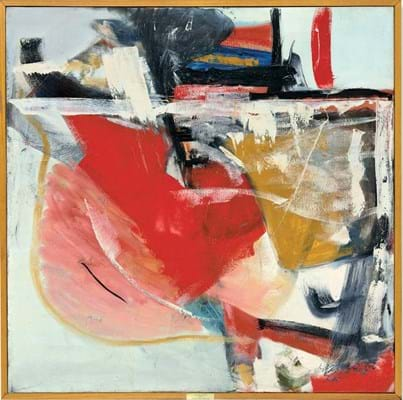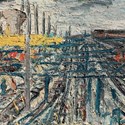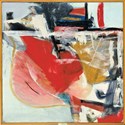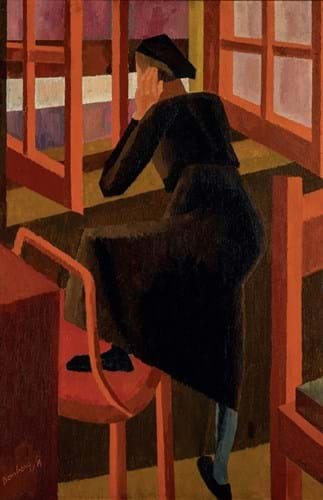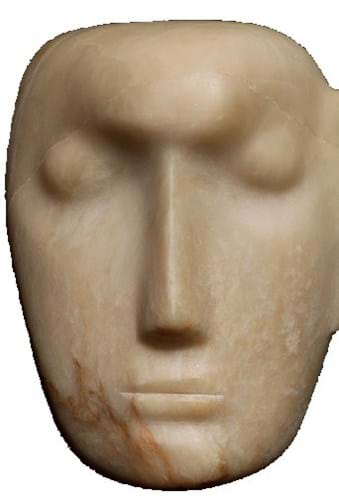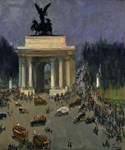To recap, the multi-million-pound sale set numerous Mod Brit records and gave the market the type of global exposure only a figure like Bowie could achieve.
The latest auctions, held in London two years to the month after the benchmark Bowie sale, certainly showed that prices have kicked on for some of those artists championed by the Ziggy Stardust singer – even if greater selectivity was evident elsewhere.
Perhaps most fitting was the £1.05m record for Cornish painter Peter Lanyon (1918-64) at Christie’s, beating the major high set at the Bowie auction.
The artist Leon Kossoff (b.1926), a chronicler of London’s streets, is another who drew attention back in 2016 but is doing even better now. He also made it into the £1m club with a record at Christie’s last month.
“Bowie certainly did no harm to the Modern British market, and if I’m honest it has helped move things up a notch for certain artists,” said Dr Robert Travers of London gallery Piano Nobile.
Together, Sotheby’s and Christie’s (25/20/12.9 or 12.5% buyer’s premium) dispensed with £27.3m of Mod Brit art in four sales across November 19-20.
Bonhams brought the total to just under £32m with its dedicated offering the week before, while further sales at Sotheby’s of Scottish art and the Brian P Burns collection of Irish art, as well as a big contingent of Mod Brit pictures at Christie’s dispersal of Annabel’s nightclub, boosted takings to nearly £40m.
While there were pockets when bidding felt a bit flat, selling rates hovered around a respectable 80% for the major evening sales at Sotheby’s and Christie’s.
“Like all these things, results have to be taken in context and examined carefully,” said Travers. “The overall total for the week, which was around £40m, is remarkable really. It is easy to take these numbers for granted nowadays but you don’t have to go back far to find that that is a massive increase. Around 20 years ago the average turnover was £3m-4m, so it has been a ten-fold increase in that period of time.”
“ Bowie certainly did no harm to the Modern British market, and if I’m honest it has helped move things up a notch for certain artists
Much of the market’s rise has been fuelled by overseas demand for blue-chip names. The quality of Mod Brit art, together with its more modest price tag (compared to contemporary or Impressionist art), have helped its successful export.
The much-courted Chinese buyers, evident during the latest series, are still marginal but their influence looks set to grow, added Travers.
Christie’s
At £14.8m, its evening sale on November 19 fetched the most money across all the sales and achieved several notable records.
As mentioned above, Peter Lanyon’s record was set at £1.05m for Orpheus, a fiery abstract creation telling the myth of Orpheus and Eurydice. The 5ft (1.52m) square oil on canvas was acquired by the vendor in 1962 and had not been seen publicly since the 1968 retrospective at the Tate Gallery. Guided at £500,000-700,000, it bettered the record £797,000 premium-inclusive paid at Sotheby’s Bowie/Collector for 1961 canvas Witness.
Willesden Junction – Autumn Afternoon sets the record for Leon Kossoff. Painted in 1971, it was billed by the auction house as “one of the most dynamic renderings of Kossoff’s favourite London scene, the station”. Depicted in two swathes of thick impasto paint and vivid colours, the 3ft x 6ft (92cm x 1.83m) oil on board sold towards its top guide for £1.15m, a significant increase on the previous premium-inclusive high of £690,850 set at Sotheby’s in 2011.
LS Lowry’s (1887-1976)A Northern Race Meeting, discussed in News Digest, ATG No 2369, topped the series with an estimate-busting £4.5m. It had remained in the same family for over half a century and was purchased the year the work was completed in 1956.
Also offered for the first time was Stanley Spencer’s (1891-1959) 1940 oil Caulking. Part of the Shipbuilding series commissioned by the War Artist’s Advisory Committee in 1940, Caulking was the only work from the series that had remained in a private collection and not in a museum. It sold towards its lower guide to an anonymous buyer at £1.7m.
Sotheby’s
A highlight of Sotheby’s £9m evening sale on November 20 was William Roberts’ (1895-1980) evocative oil The Joke, which was appearing on the market for the first time.
Acquired by the grandfather of the previous owner from Roberts’ first solo exhibition in 1923, it sold comfortably over estimate at £820,000 – the second-highest price for the artist at auction.
Dating to the best period of Roberts’ career, when he was producing his most accomplished and original compositions, the 2ft 5in x 2ft (75 x 62cm) oil on canvas depicts the heady Bohemian London nightlife in the 1920s and the great sense of excitement that abounded during this post-war period.
By contrast, David Bomberg’s (1890-1957) At the Window is a bitter depiction of life after the First World War. The portrait, modelled by his sister Raie, was described by Sotheby’s as a “masterpiece of Modernism, painted by an artist seeking to find a personal artistic language, which would speak to the tumultuous age in which he lived”.
Bomberg spent time on the Somme, experiencing the horror of trench warfare first hand. The experience proved so trying that he eventually shot himself in the foot, narrowly escaping the firing squad as a deserter.
The 2ft 5in x 19in (75 x 49cm) oil had formed part of eight deaccessioned lots from the collection of the Ben Uri Gallery & Museum in London, a controversial consignment that has prompted 11 advisers from the museum to resign in protest.
This group, which included Bomberg’s English Woman and At the Window (shown on the facing page), and Mark Gertler’s Nude, went on to raise over £1m.
The top lot of the evening sale was Henry Moore’s (1898-1986) 1947 maquette for the seminal Family Group, described by the auction house as “a perfect expression of the sculptor’s lifelong obsession with the universal motif of parenthood”.
Appearing at auction for the first time, having previously been in the collections of The Museum of Modern Art in New York and art dealer Jeffrey Loria, it emerged from a Japanese private collection to sell for £1.2m, just below hopes of £1.3m-1.8m.
Bonhams
A small sculpture by Henry Moore was the runaway star of Bonhams’ (25/20/12.5% buyer’s premium) Modern British and Irish art sale in New Bond Street.
Included on November 14, Mask was one of 12 known small carvings with the same title but the only one carved from alabaster.
Of the 12 masks carved by Moore between 1924-30, over half are held by Tate, The Henry Moore Foundation, Leeds City Art Gallery and The Sainsbury Collection in Norwich.
The 7½in (19cm) high piece at Bonhams was created in 1929 and shows the impact of the 9th century Toltec-Maya chac-mool sculpture from Yucatan in Mexico, which Moore first saw at the Trocadero Museum in Paris in 1922.
Offered for sale for the first time in more than 80 years with an estimate of £1m-1.5m, it sold to one of three bidders for £2.7m, the most valuable 1920s sculpture by a British artist at auction, according to the Art Sales Index.
Matthew Bradbury, Bonhams’ director of Modern British and Irish art, described it as “arguably the most visually appealing and beautiful example from the Mask series that Moore executed between 1924 and 1930”.
These small early heads certainly punch above their weight at auction in comparison to Moore’s later large-scale works. In June this year, Christie’s sold a marginally larger Hopton wood stone sculpture head, carved c.1934-36, for a premium-inclusive £4.62m.



